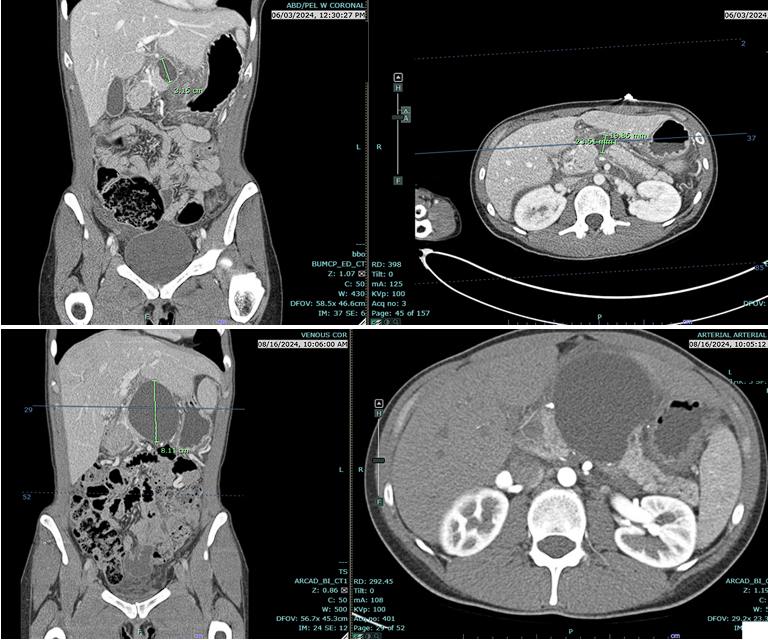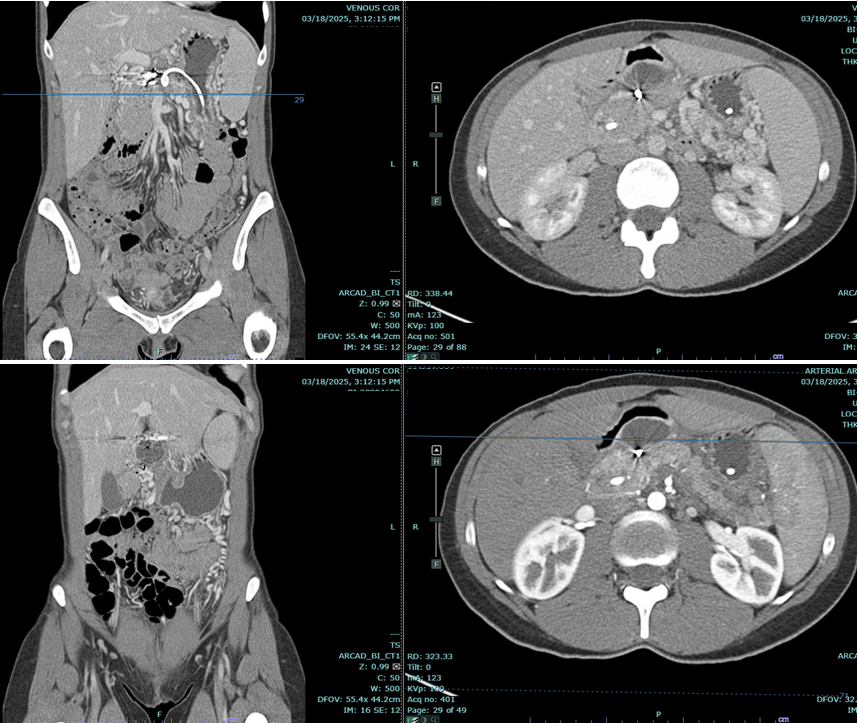Sunday Poster Session
Category: Biliary/Pancreas
P0181 - Post-Abdominal Trauma While Bench Pressing: A Rare Case of Acute Pancreatitis with Recurrent Pancreatic Pseudocysts
Sunday, October 26, 2025
3:30 PM - 7:00 PM PDT
Location: Exhibit Hall
- SN
Sophie Nguyen, BS
University of Arizona College of Medicine, Phoenix
Phoenix, AZ
Presenting Author(s)
Sophie Nguyen, BS1, Derek Scholes, MD, RDN1, Vanessa Eller, MD1, Kevin Liu, MD2, Mustafa Nawaz, DO2
1University of Arizona College of Medicine, Phoenix, Phoenix, AZ; 2Banner University Medical Center, Phoenix, AZ
Introduction: Post-traumatic pancreatic injury is rare (0.2%–12% of abdominal trauma) but is associated with high morbidity with complications including pancreatic ductal strictures, pancreatic duct leaks/fistulas, and pseudocysts. We report a rare case of traumatic pancreatitis following blunt abdominal trauma from bench pressing complicated by pancreatic duct leak and pseudocyst formation.
Case Description/
Methods: A 27-year-old female presented to our institution after developing severe epigastric pain radiating to the back when she attempted to barbell bench press 135lbs while inebriated and inadvertently dropped the barbell onto her mid-abdomen. She was found to have acute interstitial pancreatitis on initial imaging and was managed conservatively and discharged. Several months later she represented with worsening abdominal pain and nausea/vomiting. A repeat CT demonstrated interval development of multiple pancreatic pseudocysts with a larger 8 cm cyst arising from the body of the pancreas. She underwent EUS-guided cystgastrostomy with placement of a 20 mm AXIOS lumen apposing metal stent into the larger pseudocyst as well as ERCP with pancreatogram demonstrating a pancreatic duct leak in the neck of the pancreas with subsequent placement of a 5 Fr by 12 cm pancreatic duct stent.
Post-discharge, the patient developed hemorrhagic shock due to upper GI bleeding from a gastroduodenal pseudoaneurysm, which was successfully treated with IR embolization. A follow-up CT demonstrated a significant interval decrease in size of pancreatic pseudocysts and the cystgastrostomy stent was removed and exchanged for a 7 Fr by 5 cm double pigtailed plastic stent across the cystgastrostomy tract. At 5-month follow-up, CT showed continued interval decrease in size of pseudocysts with small residual pseudocyst. She continues to demonstrate small pancreatic duct leak in the neck of the pancreas on follow-up ERCP and is undergoing continued pancreatic duct stenting for management.
Discussion: To our knowledge, this is the first case of acute pancreatitis complicated by pancreatic duct leak and pseudocyst formation in an adult patient following blunt abdominal trauma from barbell bench pressing. This case highlights the importance of early recognition of acute pancreatitis as a potential differential in blunt abdominal trauma.

Figure: Figure 1: Initial CT showing a 3 cm pseudocyst (above). CT at 2 month follow-up without intervention illustrating 8 cm pseudocyst (below).

Figure: Figure 2: 5 month follow-up CT post cystogastric drainage with maintained pigtail stent. Pseudocyst has decreased in size but has not yet completely resolved.
Disclosures:
Sophie Nguyen indicated no relevant financial relationships.
Derek Scholes indicated no relevant financial relationships.
Vanessa Eller indicated no relevant financial relationships.
Kevin Liu indicated no relevant financial relationships.
Mustafa Nawaz indicated no relevant financial relationships.
Sophie Nguyen, BS1, Derek Scholes, MD, RDN1, Vanessa Eller, MD1, Kevin Liu, MD2, Mustafa Nawaz, DO2. P0181 - Post-Abdominal Trauma While Bench Pressing: A Rare Case of Acute Pancreatitis with Recurrent Pancreatic Pseudocysts, ACG 2025 Annual Scientific Meeting Abstracts. Phoenix, AZ: American College of Gastroenterology.
1University of Arizona College of Medicine, Phoenix, Phoenix, AZ; 2Banner University Medical Center, Phoenix, AZ
Introduction: Post-traumatic pancreatic injury is rare (0.2%–12% of abdominal trauma) but is associated with high morbidity with complications including pancreatic ductal strictures, pancreatic duct leaks/fistulas, and pseudocysts. We report a rare case of traumatic pancreatitis following blunt abdominal trauma from bench pressing complicated by pancreatic duct leak and pseudocyst formation.
Case Description/
Methods: A 27-year-old female presented to our institution after developing severe epigastric pain radiating to the back when she attempted to barbell bench press 135lbs while inebriated and inadvertently dropped the barbell onto her mid-abdomen. She was found to have acute interstitial pancreatitis on initial imaging and was managed conservatively and discharged. Several months later she represented with worsening abdominal pain and nausea/vomiting. A repeat CT demonstrated interval development of multiple pancreatic pseudocysts with a larger 8 cm cyst arising from the body of the pancreas. She underwent EUS-guided cystgastrostomy with placement of a 20 mm AXIOS lumen apposing metal stent into the larger pseudocyst as well as ERCP with pancreatogram demonstrating a pancreatic duct leak in the neck of the pancreas with subsequent placement of a 5 Fr by 12 cm pancreatic duct stent.
Post-discharge, the patient developed hemorrhagic shock due to upper GI bleeding from a gastroduodenal pseudoaneurysm, which was successfully treated with IR embolization. A follow-up CT demonstrated a significant interval decrease in size of pancreatic pseudocysts and the cystgastrostomy stent was removed and exchanged for a 7 Fr by 5 cm double pigtailed plastic stent across the cystgastrostomy tract. At 5-month follow-up, CT showed continued interval decrease in size of pseudocysts with small residual pseudocyst. She continues to demonstrate small pancreatic duct leak in the neck of the pancreas on follow-up ERCP and is undergoing continued pancreatic duct stenting for management.
Discussion: To our knowledge, this is the first case of acute pancreatitis complicated by pancreatic duct leak and pseudocyst formation in an adult patient following blunt abdominal trauma from barbell bench pressing. This case highlights the importance of early recognition of acute pancreatitis as a potential differential in blunt abdominal trauma.

Figure: Figure 1: Initial CT showing a 3 cm pseudocyst (above). CT at 2 month follow-up without intervention illustrating 8 cm pseudocyst (below).

Figure: Figure 2: 5 month follow-up CT post cystogastric drainage with maintained pigtail stent. Pseudocyst has decreased in size but has not yet completely resolved.
Disclosures:
Sophie Nguyen indicated no relevant financial relationships.
Derek Scholes indicated no relevant financial relationships.
Vanessa Eller indicated no relevant financial relationships.
Kevin Liu indicated no relevant financial relationships.
Mustafa Nawaz indicated no relevant financial relationships.
Sophie Nguyen, BS1, Derek Scholes, MD, RDN1, Vanessa Eller, MD1, Kevin Liu, MD2, Mustafa Nawaz, DO2. P0181 - Post-Abdominal Trauma While Bench Pressing: A Rare Case of Acute Pancreatitis with Recurrent Pancreatic Pseudocysts, ACG 2025 Annual Scientific Meeting Abstracts. Phoenix, AZ: American College of Gastroenterology.
